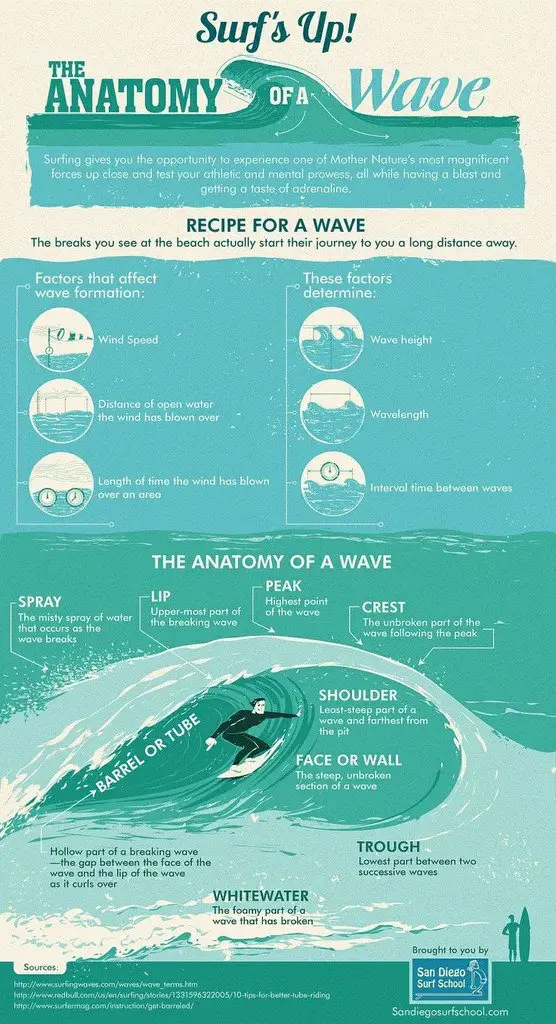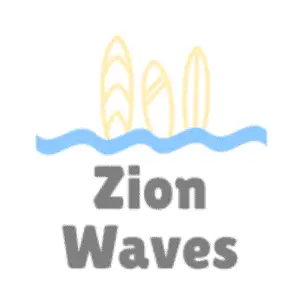If you have ever been around surfers, or just seen them in Youtube videos, you’ve probably heard them talking excitedly about getting “pitted.” But if you don’t know surfer lingo, you may be wondering what they are talking about. Is “pitted” a good or bad thing?
Getting “pitted” is the ultimate rush in surfing. It means you are riding close to the heart of a big wave, where the water curls over and starts to look like a tunnel of rushing water. In the “pit” you are practically surrounded by the wave as you use the most of its power to push you forward.
You can’t learn surfing by reading about it; you’ll need a friend who’s an experienced surfer or an instructor to show you how. But I can at least give you a head start on learning the lingo if you are at all interested in this exciting sport. Read on to learn more.
The Anatomy of a Big Wave & Getting “Pitted”
Ocean waves begin as swells out in the ocean. As the wind blows across the surface, water rises and falls and begins to move. The swell may seem small: just a couple of inches up or down, but they gain momentum as they move and the wind continues to blow.
The wave will get to be more prominent as it moves closer to shore. In shallower water it slows down. That compresses the swell, which grows in height until it becomes a wave that a surfer can ride.
Imagine you are on the shore and a wave is coming right at you. The very top of the wave is its crest. Ahead of that, where the water is starting to rise, is its “face” or “wall.”
The face is where surfers want to be. The water here rises as it flows to the shore. The surfer uses the rising water as a sort of moving ramp, and that provides the force to propel her surfboard forward.
If the wave is large enough, the wave’s crest will rush ahead, curling over its face to create a “lip.” On the left and right, the wave as a whole won’t be quite so tall: These are the “shoulders.” The surfer won’t want to hang out there, though.
The thrills will be closer to the middle of the wave. As it gets closer to the shore, the lip will curve further and further ahead of the face, creating a cylinder of moving water. This is the surfer’s ultimate goal: the “barrel” or “tube” or “pit.”
Here’s a picture to illustrate the whole thing. If a surfer can get on a big wave and make his way into that barrel when it forms, he’s “pitted.” As you can imagine, a surfer who’s just been pitted will be really “stoked!”


Some Surfing Terms
“Pitted” and “stoked” aren’t the only words you’ll want to know if you’re planning on immersing yourself in the world of surfing. Here’s some more surfing lingo you’ll want to know if you’re interested in this sport:
Bailout/Bail: Intentionally cutting off a surfing run early. A surfer may “bailout” of a ride to avoid hazards such as rocks, reefs, or coral.
Barney/Kook: A poor surfer. Someone who does not understand surf culture and etiquette.
Carve: Making a tight turn while riding a wave.
Drop-in: When a surfer attempts to ride on a wave that another surfer is already riding on. This can lead to collisions and is considered both dangerous and a breach of surf etiquette.
Duck Dive: This is a maneuver surfers will usually make while swimming out to get into position to catch a wave. When a wave comes in that could push him back toward the shore, the surfer will duck under the water with his board, allowing the wave to pass over him. The maneuver will look like a duck sticking its head underwater.
Flat: Surfing is “flat” when waves are small or nonexistent. A poor day for surfing.
Goofy/Regular Foot: A “Goofy” surfer will ride with his left foot back and his right foot forward. Most surfers ride with their left foot in front. Either way will work.
Gun: A larger than usual board useful for big waves or for surfers who want to try to “hang ten.”
Hang Loose: Relax, unwind, “chill out.”
Hang Ten: this is a pretty advanced, “old school” move where the surfer moves to the very front of the board so that all his toes can curl over the leading edge. “Hanging Ten” requires excellent balance and a lot of experience on the waves.
Leash: A cable attaching a surfer’s board to his ankle. The leash prevents the board from being lost after a wipeout. The surfer can swim back to the shore dragging his board behind him.
Line-Up: The queue formed by surfers as they move into position to catch waves. It is considered rude to cut in front of the line once it forms.
Pop-Up: The move a surfer makes when he is about to start riding a wave. Typically a surfer will go into the water with his stomach on his board then swim into position. When he is ready to start surfing, he will “pop up” to stand on the board.
Quiver: A surfer’s collection of boards. Experienced surfers will have larger quivers, giving them the ability to choose a board that suits the waves.
Shaka Sign: A hand signal you make by extending your thumb and pinky while curling up your other three fingers. It means “chill out” or “relax.”
Shortboard: A smaller than average board used by beginners or on smaller waves.
Wax: Surfers use a paraffin-based wax to increase the friction that their boards have in the water. This means more energy is transferred to the board by a wave, so the surfer travels faster.
Wettie: A wetsuit. Wearing one will allow a surfer to ride waves in cooler weather.
Wipeout: When a surfer loses his balance and falls off his board. This tends to happen to beginning surfers.
Testing the Lingo: Catching a Wave
Surfing a wave starts by getting into the water and paddling out while lying down on the board (gun or shortboard). Once she is far enough out from the shore, the surfer will look for a promising wave or swell, then paddle back, trying to match the wave’s direction and speed.
Once she is at the front of the wave, she will jump quickly on top of the board (pop up). If she has timed it right, she should be able to steer the board into the middle of the wave and ride it back the rest of the way.
But spotting a good wave, and timing your jump, takes skill and practice. If you don’t have a friend who can teach you, there are surf schools all along the Atlantic and Pacific coasts and Hawaii.
There is also etiquette of which you should be aware.
In particular, it can be very dangerous to have more than one person ride a wave at a time or do a “drop-in.” Surfers need room to maneuver along the front of a wave, and if there’s more than one surfer, there’s a severe risk that they will crash into each other or that one of them will have to intentionally cut off his run (bailout).
Conclusion
Catching a great wave and riding it can be a real thrill, as this guy below can attest. The key is to know what you’re doing.
Before you go out, you should have someone teach you basic surfing techniques. It helps to know how waves form and how they act as they get close to the shore. You also want to have a board that works for your size and skill level.
But if you are well prepared, you should have a great time surfing, and maybe feel the rush as you get pitted yourself!

